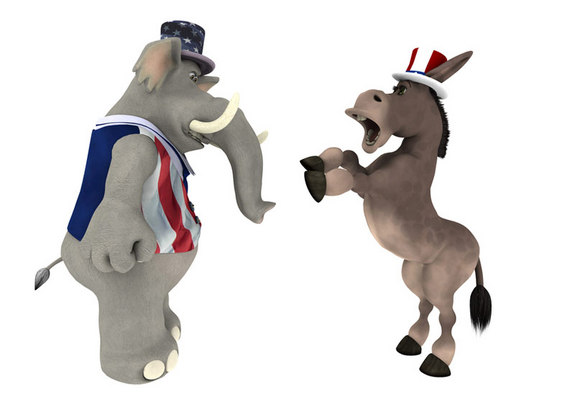Americans' Political Views Not So Far Apart

SAN DIEGO — In an election year, it's hard to turn on the television or read a newspaper without getting the sense that Americans are becoming ever more divided into red versus blue. But a new study finds that perception may be downright wrong.
In fact, political polarization among the public has barely budged at all over the past 40 years, according to research presented here on Jan. 27 at the annual meeting of the Society for Personality and Social Psychology. But, crucially, people vastly overestimate how polarized the American public is — a tendency toward exaggeration that is especially strong in the most extreme Democrats and Republicans. (The results do not apply to Congress, politicians or media pundits, but rather to the general public.)
"Strongly identified Republicans or Democrats perceive and exaggerate polarization more than weakly identified Republicans or Democrats or political independents," said study researcher John Chambers, a professor of psychology at the University of Florida.
The people who see the world split into two opposing factions are also most likely to vote and become politically active, Chambers said in a talk at the meeting. This means that while real growing polarization is illusory, the perception of polarization could drive the political process.
Growing divide?
Inspired by polling data showing that two-thirds of Americans believe the United States is becoming more politically polarized, with the gap between the political parties widening, Chambers and his colleagues looked at nationally representative data stretching from 1970 to 2004. More than 43,000 respondents over the years have participated in the large-scale American National Election Survey, though not all answered all questions. So the researchers had between 4,000 and 26,000 individuals to work with on various questions.
The respondents indicated their political beliefs by answering questions on their opinions on a wild variety of issues, from government-provided health care to defense spending to women's equality. They also reported how they believe a "typical" Republican and Democrat would feel about these same issues.
Sign up for the Live Science daily newsletter now
Get the world’s most fascinating discoveries delivered straight to your inbox.
"Using these two measures, we were able to look at actual and perceived differences in polarization," Chambers said.
They found that actual polarization has remained steady since the 1970s. The historical responses also showed that people have always overestimated polarization. Even decades ago, in times now remembered as cooperative and cordial, people pegged political disagreements as much more vast than they really were. [Life's Extremes: Democrat vs. Republican]
When the researchers broke down the respondents by political positions, they found that not everyone judges polarization in the same way. Everyone overestimates it, but political independents are much closer to the mark than strong Republicans or strong Democrats, who tend to see the gulf between themselves and the other party as impossibly wide. Moderate Republicans and moderate Democrats were in-between, perceiving more polarization than independents but less than the extreme ends of the parties.
Projecting polarization
In a separate study also presented here, University of Colorado, Boulder, psychology professor Leaf Van Boven looked at why people at the political extremes might overestimate polarization. The answer seems to be that they project their own strong, emotional thought processes onto others, Van Boven and his colleagues concluded. In their study, they presented students with a fictional policy that would try to lure out-of-state students to campus with preferential treatment, including first pick of classes and dorms.
Unsurprisingly, this fake proposal yielded polarized views. "This proposal is bulls---!" one student wrote. Another indicated support, adding, "I am biased, because I am out of state, and I want the sweet hookups."
When the researchers asked students to indicate how they though other students felt about the proposal, those who themselves opposed or supported it most strongly assumed that others would also feel strongly, in support or opposition.
When asked how they came to their conclusions about the proposal and how they believed others came to their conclusions, the students gave themselves credit for more fairness and less self-interest than they did others. But they also assumed that everyone gave equal weight to emotion and extensive thought.
"If someone has a strong moral reaction and says 'This is a moral issue', they may reasonably think that others, both on their side and other side, will think in the same way," Van Boven explained.
While political elites, such as political operatives, Congress and media pundits, are "another story," according to Chambers, the results of the polarization studies provide "reason for optimism and hope," he said.
"Although we tend to see the world as divided between blue and red, in reality, the world has much greater shades of purple," Chambers said. "There is more common ground than we realize."
You can follow LiveSciencesenior writer Stephanie Pappas on Twitter @sipappas. Follow LiveScience for the latest in science news and discoveries on Twitter @livescienceand on Facebook.

Stephanie Pappas is a contributing writer for Live Science, covering topics ranging from geoscience to archaeology to the human brain and behavior. She was previously a senior writer for Live Science but is now a freelancer based in Denver, Colorado, and regularly contributes to Scientific American and The Monitor, the monthly magazine of the American Psychological Association. Stephanie received a bachelor's degree in psychology from the University of South Carolina and a graduate certificate in science communication from the University of California, Santa Cruz.










